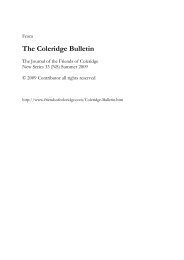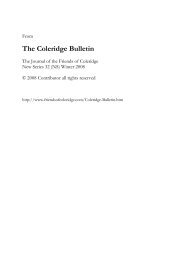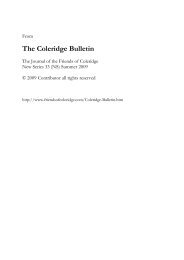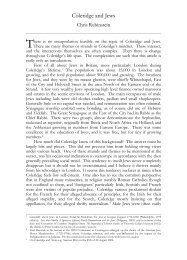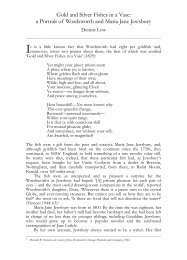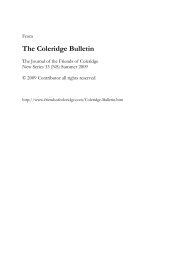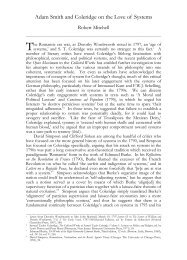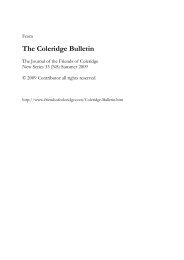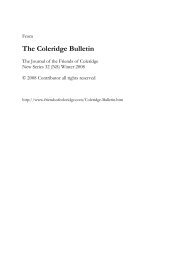My pensive Sara - The Friends of Coleridge
My pensive Sara - The Friends of Coleridge
My pensive Sara - The Friends of Coleridge
Create successful ePaper yourself
Turn your PDF publications into a flip-book with our unique Google optimized e-Paper software.
‘Restore me to Reality’<br />
Revisiting <strong>Coleridge</strong>’s Figure <strong>of</strong> ‘<strong>My</strong> <strong>pensive</strong> <strong>Sara</strong>’<br />
Catherine E. Ross<br />
____________________________________________________________________________________________<br />
‘M<br />
A relation (always social) determines the terms and not the reverse.<br />
Michel De Certeau 1<br />
y Pensive <strong>Sara</strong>’ is the name Samuel Taylor <strong>Coleridge</strong> and Charles Lamb<br />
habitually used to refer to the poem that we now call ‘<strong>The</strong> Eolian<br />
Harp.’ STC <strong>of</strong>ten quoted portions <strong>of</strong> this lyric in his letters and told friends in<br />
1796 it was ‘my favorite <strong>of</strong> my poems.’ 2 Today, speaking for the majority <strong>of</strong><br />
critics, Paul Magnuson has aptly labeled ‘<strong>The</strong> Eolian Harp’ ‘one <strong>of</strong> <strong>Coleridge</strong>’s<br />
most important and romanticism’s most seminal poems.’ 3 Scholars cite<br />
various reasons for ‘<strong>The</strong> Eolian Harp’s pride <strong>of</strong> place: among them are its<br />
inaugural expression <strong>of</strong> the ‘grand Romantic idea <strong>of</strong> the ‘One life’ ’; 4 its<br />
depictions <strong>of</strong> the Romantic imagination at work; 5 and its innovative and<br />
distinctive conversational structure. 6 While these and other commentaries on<br />
the poem have made important contributions to critical understanding <strong>of</strong> this<br />
text, none, to my mind, has looked carefully or kindly enough at <strong>Coleridge</strong>’s<br />
original representation <strong>of</strong> the character who signals the crisis at the heart <strong>of</strong> the<br />
narrative, the speaker’s beloved, if <strong>pensive</strong>, <strong>Sara</strong>.<br />
To revisit and perhaps resuscitate the figure <strong>of</strong> ‘<strong>Sara</strong>,’ I shall focus upon<br />
certain events, relationships, and texts in <strong>Coleridge</strong>’s life that date from 1790 to<br />
1796, the years leading up to and including the composition and publication <strong>of</strong><br />
the earliest version <strong>of</strong> ‘<strong>The</strong> Eolian Harp’ in Poems on Various Subjects (1796). It<br />
is a version that did not yet boast the heralded ‘one life’ passage, thus making it<br />
a substantially different poem than the one we call ‘<strong>The</strong> Eolian Harp’. 7 Indeed,<br />
<strong>Coleridge</strong> gave this text a radically different title: ‘Effusion XXXV.<br />
Composed August 20 th , 1795, at Clevedon, Somersetshire.’ 8 <strong>My</strong> research<br />
____________________________________________________________________________________________<br />
1 Michel De Certeau, <strong>The</strong> Practice <strong>of</strong> Everyday Life (University <strong>of</strong> California Press, 1984), xi.<br />
2 Earl Leslie Griggs, ed., Collected Letters <strong>of</strong> Samuel Taylor <strong>Coleridge</strong>, 1, (Clarendon Press, 1954), pp. 294-295. Hereafter<br />
cited as CL.<br />
3 Paul Magnuson, ‘ “<strong>The</strong> Eolian Harp” in Context,’ in Studies in Romanticism, 24 (Spring 1985): 3-20, 3.<br />
4 Albert Gérard, ‘Counterfeiting Infinity: “<strong>The</strong> Eolian Harp” and the Growth <strong>of</strong> <strong>Coleridge</strong>’s Mind,’ in Journal <strong>of</strong><br />
English and Germanic Philology, 60 (1961): 411-422, 411.<br />
5 Wilson Knight, <strong>The</strong> Starlit Dome (Oxford University Press, 1941), 99.<br />
6 Ronald Wendling, ‘<strong>Coleridge</strong> and the Consistency <strong>of</strong> ‘<strong>The</strong> Eolian Harp’,’ in Studies in Romanticism, 8 (Autumn 1968):<br />
26-42, 26.<br />
7<br />
Prior to the publication <strong>of</strong> J. C. C. May’s four-volume edition <strong>of</strong> <strong>Coleridge</strong>’s poems, <strong>The</strong> Collected Works <strong>of</strong> Samuel<br />
Taylor <strong>Coleridge</strong>, Poetical Works (Princeton University Press, copyright 2001, but only available within the last twelvemonth),<br />
Paul Cheshire’s article on ‘<strong>The</strong> Eolian Harp,’ in <strong>The</strong> <strong>Coleridge</strong> Bulletin, 17 (Summer 2001): 1-22 was the most<br />
complete scholarly discussion <strong>of</strong> the successive versions <strong>of</strong> ‘<strong>The</strong> Eolian Harp.’ Cheshire’s essay includes an<br />
innovative and very useful fold-out that tracks the changes in each version, and aptly argues that ‘the whole<br />
sequence [is] a single kinetic metapoem, whose very changes are a form <strong>of</strong> poetry’ (2).<br />
8 J. C. C. Mays’ edition <strong>of</strong> <strong>Coleridge</strong>’s poems was not yet available at the time I began this paper, so I used a first<br />
edition <strong>of</strong> Poems on Various Subjects (1796) in the collection <strong>of</strong> the Harry Ransom Center at the University <strong>of</strong> Texas at<br />
Austin for all quotations from ‘<strong>The</strong> Eolian Harp.’ <strong>The</strong> poem appears on pages 96-100 <strong>of</strong> that edition and is titled:
75 Revisiting <strong>Coleridge</strong>’s Figure <strong>of</strong> “<strong>My</strong> <strong>pensive</strong> <strong>Sara</strong>”<br />
____________________________________________________________________________________________<br />
suggests that the figure <strong>of</strong> ‘<strong>pensive</strong> <strong>Sara</strong>’ as conceived in 1795-6 is more<br />
complicated than we have heret<strong>of</strong>ore recognized and that ‘<strong>Sara</strong>’ operates as an<br />
essential agent in protecting and sustaining the speaker’s source <strong>of</strong> poetic<br />
power. Moreover, I believe that in <strong>Coleridge</strong>’s construction <strong>of</strong> the figure <strong>of</strong><br />
‘<strong>Sara</strong>’ and his fashioning <strong>of</strong> the conclusion <strong>of</strong> ‘Effusion XXXV,’ the poet<br />
<strong>of</strong>fers a positive representation <strong>of</strong> womankind and an alternative narrative <strong>of</strong><br />
<strong>The</strong> Fall, both <strong>of</strong> which challenge those in Milton’s Paradise Lost.<br />
To understand the figure <strong>of</strong> ‘<strong>Sara</strong>,’ we must first consider the nature <strong>of</strong> the<br />
poem’s narrator, whom scholars view as one <strong>of</strong> the period’s earliest<br />
representations <strong>of</strong> the Romantic Poet. This poet is a creature who luxuriates in<br />
the ‘soothing sweet[ness]’ (2) <strong>of</strong> sitting in his cottage garden with a pretty<br />
woman. He makes much <strong>of</strong> nature, turning jasmine and myrtle into ‘Meet<br />
emblems… <strong>of</strong> innocence and love’ (5). He is well read and capable <strong>of</strong> drawing<br />
upon various archetypal stories, fairy tales, and theories <strong>of</strong> both metaphysicians<br />
and contemporary physicians for his ideas and imagery. His brain is ‘indolent<br />
and passive’ (33), like the Eolian harp, and many ‘idle flitting phantasies’ (32)<br />
blow through him, as the wind blows through the harp strings. Thus the<br />
reader is invited not only to hear Eolian harp music and to see the figural<br />
productions <strong>of</strong> the speaker’s mind, such as ‘twilight Elfins’ (21) and ‘birds <strong>of</strong><br />
Paradise’ (24), but also to imagine the ways in which the Romantic Poet is like<br />
a sensitive, finely tuned instrument, poised to make poetry out <strong>of</strong> whatever<br />
comes his way. This creative individual is not, however, a solitary being; he is a<br />
man who loves and is pr<strong>of</strong>oundly influenced by the presence and beliefs <strong>of</strong> a<br />
woman he calls ‘heart-honor’d’ (56). Finally, <strong>Coleridge</strong>’s poet in ‘<strong>My</strong> Pensive<br />
<strong>Sara</strong>’ reverently acknowledges a merciful, if ‘INCOMPREHENSIBLE’ (51), God<br />
and aspires to a ‘Faith that inly feels’ (52). 9<br />
Typically, scholars’ evaluations <strong>of</strong> the representation <strong>of</strong> the Romantic Poet<br />
and his project in ‘Effusion XXXV’ are sympathetic, and their interpretations<br />
<strong>of</strong> the poem’s conclusion <strong>of</strong>ten hinge upon their understanding <strong>of</strong> his<br />
relationship with the poem’s other character, ‘<strong>pensive</strong> <strong>Sara</strong>.’ <strong>The</strong> conventional<br />
assumption is that ‘<strong>Sara</strong>’ refers to <strong>Coleridge</strong>’s wife, <strong>Sara</strong>h Fricker. <strong>The</strong><br />
specificity <strong>of</strong> the date in the poem’s title (just two months prior to their<br />
marriage); the setting in Clevedon (the newlyweds’ first home); and STC’s<br />
tendency to use autobiographical material elsewhere in his poetry support this<br />
inference. Indeed, Magnuson has commented that it would be difficult to see<br />
‘Effusion XXXV’ as anything other than ‘a set <strong>of</strong> private associations.’ 10<br />
Because Mrs. <strong>Coleridge</strong> has been saddled with a reputation for being<br />
‘Effusion XXV. Composed August 20 th , 1795, At Clevedon, Somersetshire.’ To make it clear that I am referring<br />
to the earliest published version <strong>of</strong> the poem, I will cite it throughout this paper as either ‘Effusion XXXV’ or ‘<strong>My</strong><br />
Pensive <strong>Sara</strong>.’ Subsequent parenthetical citations refer to lines in this text.<br />
9 It is significant that the only words in the poem that are printed in all capital letters are ‘INCOMPREHENSIBLE,’<br />
‘SARA’ (in the first line <strong>of</strong> the poem), as well as ‘PEACE,’ ‘COT,’ and ‘THEE’ (all <strong>of</strong> which appear in the last line<br />
<strong>of</strong> the poem). <strong>The</strong>se orthographic decisions suggest the honor the poet accorded the figure <strong>of</strong> ‘<strong>Sara</strong>.’.<br />
10 Paul Magnuson, <strong>Coleridge</strong> and Wordsworth: A Lyrical Dialogue (Princeton University Press, 1988), 145.
Revisiting <strong>Coleridge</strong>’s Figure <strong>of</strong> “<strong>My</strong> <strong>pensive</strong> <strong>Sara</strong>” 76<br />
____________________________________________________________________________________________<br />
insensitive to her husband’s work and suspicious <strong>of</strong> the Wordsworths’<br />
influence upon him, the correlation <strong>of</strong> <strong>Sara</strong>h Fricker with ‘<strong>pensive</strong> <strong>Sara</strong>’ makes<br />
it easy to discount or discredit the figural representation <strong>of</strong> the speaker’s<br />
companion and her behavior while valorizing the poem’s depiction <strong>of</strong> the<br />
poet. 11<br />
For example, scholars such as Magnuson, who applaud the narrator’s<br />
supple and vigorous imagination, usually see the transition effected in line 41<br />
by <strong>Sara</strong>’s repro<strong>of</strong> as one <strong>of</strong> negation, denial, or perhaps <strong>of</strong> reduction (1985, 19).<br />
This boring, sad woman interferes with the delightfully pleasurable and almost<br />
sacred exercise <strong>of</strong> a poet’s mind. 12 Similarly, Jean Pierre Mileur contends that<br />
<strong>Sara</strong>’s interference signals nothing less than the failure <strong>of</strong> poetic imagination. 13<br />
Another common evaluation <strong>of</strong> the poem’s final lines is that they<br />
pessimistically concede the fragility <strong>of</strong> the creative faculty (however brilliant it<br />
may be) by demonstrating how vulnerable poets are, not only to critics, but<br />
also to domestic cares, their own weaknesses, and to certain conservative<br />
views, including religious ones. This conclusion, too, almost always points a<br />
damning finger at ‘<strong>Sara</strong>.’ 14<br />
Very different conclusions can be drawn from the poem if the figure <strong>of</strong><br />
‘<strong>Sara</strong>’ is connected with more historically precise reports about Miss Fricker<br />
and <strong>Coleridge</strong> in the month he wrote the poem and if more specifically detailed<br />
data about STC’s other social relationships, personal experiences, values, and<br />
____________________________________________________________________________________________<br />
11 See Richard Holmes, <strong>Coleridge</strong>, Early Visions (Viking Press, 1989), 107, regarding <strong>Sara</strong> Fricker <strong>Coleridge</strong>’s lack <strong>of</strong><br />
involvement in her husband’s literary endeavors. SFC’s unhappiness with her husband did not become fully<br />
aroused, however, until after his trip to Germany with William and Dorothy Wordsworth (1798-99), more than four<br />
years after the publication <strong>of</strong> ‘Effusion XXXV.’ For more on the rivalry between <strong>Sara</strong>h Fricker <strong>Coleridge</strong> and<br />
Dorothy Wordsworth see Molly Lefebure, <strong>The</strong> Bondage <strong>of</strong> Love, a Life <strong>of</strong> Mrs. Samuel Taylor <strong>Coleridge</strong> (Norton, 1986-7)<br />
and Kathleen Jones, A Passionate Sisterhood: <strong>The</strong> Sisters, Wives and Daughters <strong>of</strong> the Lake Poets (St. Martin’s Press, 2000).<br />
12 Unlike later printings <strong>of</strong> the text, in the 1796 edition <strong>of</strong> this poem, line 41 does not begin a new stanza. This line<br />
and the three succeeding it (ending with ‘And biddest me walk humbly with my God’) are part <strong>of</strong> the second stanza,<br />
which begins at line 26 with ‘And thus, my Love! As on the midway slop… ‘ This is the stanza that records the<br />
speaker’s ‘Romantic’ speculation about the nature <strong>of</strong> the universe (swept by a ‘Plastic and vast… intellectual<br />
Breeze… the Soul <strong>of</strong> each, and God <strong>of</strong> all’). <strong>The</strong> rhetoric <strong>of</strong> the arrangement <strong>of</strong> these lines, however, suggests that<br />
<strong>Sara</strong>’s ‘mild repro<strong>of</strong>’ and request for the speaker to ‘walk humbly with [his] God’ eclipse these ‘idle flitting<br />
phantasies.’<br />
13 In Vision and Revision, Mileur argues that <strong>Sara</strong>’s repro<strong>of</strong> causes her lover to dismiss his poetic ‘shapings’ as<br />
‘unhallow’d’ products <strong>of</strong> an ‘unregenerate mind.’ This leads him (and <strong>Coleridge</strong>) to shut down the poem in an<br />
abrupt and anticlimactic fashion. Mileur, therefore, calls the conclusion <strong>of</strong> the poem a ‘contraction’ and a failure <strong>of</strong><br />
poetic imagination. Other similarly negative readings <strong>of</strong> the ending <strong>of</strong> the poem include that <strong>of</strong> Jeanie Watson,<br />
author <strong>of</strong> Risking Enchantment, <strong>Coleridge</strong>’s Symbolic World <strong>of</strong> Faery (University <strong>of</strong> Nebraska Press, 1990), who labels the<br />
poem’s concluding lines ‘disappointing and false’ (76); and that <strong>of</strong> M. H. Abrams, who calls the concluding lines as<br />
‘inconsequent as well as anticlimactic’ in his essay ‘ ‘<strong>Coleridge</strong>’s ‘A Light in Sound’,’ in Samuel Taylor <strong>Coleridge</strong>:<br />
Modern Critical Views, Harold Bloom, ed. (Chelsea House, 1986): 67-88, 88. Ronald Wendling, on the other hand,<br />
concedes that the poem’s conclusion—and <strong>Sara</strong>’s part in it—contain ‘nothing explicitly contradictory to the two<br />
passages <strong>of</strong> romantic speculation which precede it’ (27).<br />
14 Such readings <strong>of</strong>ten cite several letters <strong>Coleridge</strong> wrote in 1794 that express the poet’s feelings for another woman,<br />
his reluctance to marry <strong>Sara</strong>h Fricker, and his fear that marriage might be disastrous for his creative and<br />
pr<strong>of</strong>essional life. See, for example, <strong>Coleridge</strong>’s letter to Southey dated 3 November 1794, in which he speaks <strong>of</strong> his<br />
abiding love <strong>of</strong> Mary Evans (CL I 121-124), as well as the letter dated 9 December 1794, in which he declares that<br />
he mistook the ‘ebullience <strong>of</strong> schematism’ for love <strong>of</strong> <strong>Sara</strong>h Fricker (CL I 132). In a letter to Southey dated 29<br />
December 1794, <strong>Coleridge</strong> promises that he ‘will [nevertheless] do [his] duty’ and marry <strong>Sara</strong>h Fricker, even though<br />
he still loves Mary Evans (CL I 145-146). Another letter about <strong>Coleridge</strong>’s enduring feelings for Evans was also<br />
written to Francis Wrangham on 24 October 1794 (CL I 120-121).
77 Revisiting <strong>Coleridge</strong>’s Figure <strong>of</strong> “<strong>My</strong> <strong>pensive</strong> <strong>Sara</strong>”<br />
____________________________________________________________________________________________<br />
beliefs during the time leading up to his composition <strong>of</strong> ‘Effusion XXXV’ are<br />
taken into consideration.<br />
A brief rehearsal <strong>of</strong> <strong>Coleridge</strong>’s well-documented history between 1792<br />
and 1795 includes the following: his becoming ‘a proverb to [his] University<br />
for Idleness’ and debauchery (CL I 67); his attempt to escape the misery and<br />
shame <strong>of</strong> debts, poor academic performance, and romantic disappointment by<br />
running away to enlist in the army; and then, a few months later, his joining<br />
Southey and the Fricker sisters in the utopian scheme <strong>of</strong> Pantisocracy.<br />
Throughout this period <strong>of</strong> emotional chaos, however, <strong>Coleridge</strong> appears to<br />
have maintained an enduring belief, as he explains in ‘Religious Musings’ (the<br />
final poem in the volume in which ‘Effusion XXXV’ first appeared), 15 that<br />
God was the origin <strong>of</strong> the ‘moral world’s cohesion.’ 16 Elsewhere in ‘Religious<br />
Musings’ <strong>Coleridge</strong>’s speaker claims that being out <strong>of</strong> touch with his maker<br />
allows the accession <strong>of</strong> ‘An Anarchy <strong>of</strong> Spirits’ (146) in which one becomes<br />
‘Toy-bewitched,/Made blind by lusts, disherited <strong>of</strong> soul,’ (146-7). Such a<br />
person is ‘A sordid solitary thing’ (149). <strong>The</strong> ideas manifest in these lines<br />
suggest that <strong>Sara</strong>’s behavior and her conversation with the narrator at the end<br />
<strong>of</strong> ‘Effusion XXXV’ should be taken more seriously. To be specific, despite<br />
the narrator’s charming, imaginative nature, he is ranging dangerously far a-<br />
field from his own life-sustaining religious beliefs, becoming bewitched by the<br />
toys <strong>of</strong> his imagination and linguistic facility and blind to the possibility that he<br />
might lose his soul along the way. Hence, <strong>Sara</strong>’s interruption <strong>of</strong> his ramblings<br />
operates as a deadly serious effort to rescue him as a man and a poet.<br />
Various pieces <strong>of</strong> historical evidence support this conclusion; for, among<br />
other things, they show that despite <strong>Coleridge</strong>’s premarital anxieties noted by<br />
many critics, during the days in which he was working on ‘Effusion XXXV,’ he<br />
and <strong>Sara</strong>h were happy in their domestic life. 17 STC wrote Southey to this<br />
effect in early August 1795 saying that ‘Domestic happiness is the greatest <strong>of</strong><br />
things sublunary’ (CL I 158). Shortly after his wedding on 4 October 1795,<br />
<strong>Coleridge</strong> wrote Thomas Poole describing the ‘solemn Joy’ <strong>of</strong> being ‘united to<br />
the woman, whom I love best <strong>of</strong> all created Beings’ (CL I 160). He happily<br />
describes how he and <strong>Sara</strong>h are ‘quite domesticated at Clevedon’ where ‘the<br />
prospect around [them] is perhaps more various than any in the kingdom,’ so<br />
that his ‘Eye gluttonizes,’ and he believes that he ‘shall assuredly write Rhymes’<br />
(CL I 160). In the spring <strong>of</strong> that same year, while lecturing in Bristol,<br />
<strong>Coleridge</strong> explained in a more general way how important he felt domestic<br />
relationships were. <strong>The</strong> searcher after Truth, he told his audience,<br />
____________________________________________________________________________________________<br />
15 <strong>The</strong> placement <strong>of</strong> ‘Religious Musings’ as the final poem in Poems on Various Subjects emphasizes how seriously<br />
<strong>Coleridge</strong> took the beliefs it expresses about the spiritual life, just as Wordsworth’s placement <strong>of</strong> ‘Tintern Abbey’ as<br />
the final poem in Lyrical Ballads announces and underscores his beliefs about nature.<br />
16 J. C. C. Mays, ed. <strong>The</strong> Collected Works <strong>of</strong> Samuel Taylor <strong>Coleridge</strong> Poetical Works, (Princeton University Press, 2001): I<br />
115 145. Hereafter cited as 16—PW. All subsequent quotations from this poem refer to this text and parenthetical<br />
citations refer to line numbers.<br />
17 See Holmes 91 and 95.
Revisiting <strong>Coleridge</strong>’s Figure <strong>of</strong> “<strong>My</strong> <strong>pensive</strong> <strong>Sara</strong>” 78<br />
____________________________________________________________________________________________<br />
must love and be beloved; for general Benevolence is a necessary<br />
motive to constancy <strong>of</strong> pursuit; and this general Benevolence is<br />
begotten and rendered permanent by social and domestic<br />
affections… (LPR 46)<br />
As Robert Barth has noted, later in life <strong>Coleridge</strong> expressed similarly<br />
positive sentiments about social and domestic relationships, especially married<br />
friendship, declaring that<br />
<strong>Friends</strong>hip satisfies the highest parts <strong>of</strong> our nature; but a wife, who is<br />
capable <strong>of</strong> friendship, satisfies all. <strong>The</strong> great business <strong>of</strong> real<br />
unostentatious Virtue is—not to eradicate any genuine instinct or<br />
appetite <strong>of</strong> human nature; but—to establish a concern & unity<br />
betwixt all parts <strong>of</strong> our nature, to give a Feeling and a Passion to our<br />
purer Intellect, and to intellectualize our feelings & passions. 18<br />
Because <strong>Coleridge</strong>’s thoughts could run along lines such as these and because it<br />
is more accurate to associate the ‘<strong>pensive</strong> <strong>Sara</strong>’ <strong>of</strong> 1795-6 with the younger,<br />
happier Mrs. <strong>Coleridge</strong>, it is possible to trace the following alternative scenario<br />
in ‘Effusion XXXV’: the speaker’s imaginative play in the early part <strong>of</strong> the text<br />
gives a Feeling and a Passion to his Intellect, and the concern and caution he<br />
subsequently sees in <strong>Sara</strong>’s eye invites him to intellectualize these feelings and<br />
passions, so they will be in harmony with his moral system. Hence, rather than<br />
being an unsympathetic or dogmatic effort to eradicate the narrator’s genuine<br />
instinct or appetite for poetry and philosophy, <strong>Sara</strong>’s business is to help him<br />
unify the different parts <strong>of</strong> his nature. In doing so with self-effacing meekness,<br />
she proves herself to be unostentatiously virtuous. This view <strong>of</strong> the<br />
relationship between the poet and <strong>Sara</strong> is also supported by <strong>Coleridge</strong>’s<br />
assertions in 1794 that the ‘leading idea’ for the members <strong>of</strong> their Pantisocratic<br />
community was ‘to make men necessarily virtuous by removing all Motives to<br />
Evil—all possible temptations’ (CL I 114) and that all members <strong>of</strong> the<br />
community should be responsible for the moral behavior <strong>of</strong> their fellows. 19<br />
Other data drawn from <strong>Coleridge</strong>’s contemporaneous correspondence<br />
suggests that he truly appreciated the regenerative power <strong>of</strong> relationships such<br />
as the one he depicts in ‘Effusion XXXV.’ Letters describing his prior<br />
____________________________________________________________________________________________<br />
18 Quoted in Robert Barth <strong>Coleridge</strong> and the Power <strong>of</strong> Love (University <strong>of</strong> Missouri Press, 1988), 15-16, n. 82.<br />
19 By the time STC was writing ‘<strong>My</strong> Pensive <strong>Sara</strong>,’ Southey had abandoned the Pantisocracy scheme. Angry and<br />
frustrated, <strong>Coleridge</strong> felt he and <strong>Sara</strong> were the last remnants <strong>of</strong> the Pantisocratic union. Other evidence that<br />
<strong>Coleridge</strong> was working out <strong>of</strong> the Pantisocratic model in ‘Effusion XXXV’ comes from the language <strong>of</strong> ‘Sonnet on<br />
Pantisocracy,’ a copy <strong>of</strong> which STC sent to Robert Southey in 1794. This sonnet explains that in their new world<br />
home the Pantisocrats will<br />
seek the cottag’d dell<br />
Where Virtue calm with careless step may stray,<br />
And dancing to the moonlight Roundelay,<br />
<strong>The</strong> wizard Passions weave an holy spell. (CW I 131 5-8)
79 Revisiting <strong>Coleridge</strong>’s Figure <strong>of</strong> “<strong>My</strong> <strong>pensive</strong> <strong>Sara</strong>”<br />
____________________________________________________________________________________________<br />
experiences with Mary Evans, a young woman whom he loved and respected,<br />
refer approvingly to the way they encouraged and monitored each other<br />
intellectually, creatively, and spiritually. We see something <strong>of</strong> what this<br />
relationship must have been like in a letter Evans wrote <strong>Coleridge</strong> when she<br />
received news about his involvement in the Pantisocracy scheme. Writing to<br />
Robert Southey on 21 October 1794, STC quoted this letter at length; and we<br />
hear echoes <strong>of</strong> his quotations in ‘Effusion XXXV.’ For example, Evans’ letter<br />
declares that despite rumors to the contrary, she knows <strong>Coleridge</strong> is still a<br />
Christian. Evans’ letter manifests appreciation <strong>of</strong>, but also concern about,<br />
aspects <strong>of</strong> <strong>Coleridge</strong>’s character that sound very much like those <strong>of</strong> the<br />
narrator in ‘Effusion XXXV.’ ‘<strong>The</strong>re is an Eagerness,’ Evans writes, ‘in your<br />
Nature, which is ever hurrying you into [rash Schemes and] the sad Extreme.’<br />
She fears that his ‘noble Mind is here o’erthrown. Blasted with Exstacy’ (CL I<br />
112). 20<br />
<strong>The</strong> language and sense <strong>of</strong> <strong>Coleridge</strong>’s answer to Evans’ letter also echo in<br />
‘Effusion XXXV.’ STC praises Evans’ ‘stores <strong>of</strong> strong understanding,’<br />
implores her to ‘Restore me to Reality,’ and applauds her gentle ‘firmness’ (CL I<br />
130, 144). In the poem, <strong>Coleridge</strong>’s speaker expresses a similar gratitude for<br />
<strong>Sara</strong>’s ‘mild repro<strong>of</strong>’ (41) and promptly accepts her viewpoint: ‘Well has thou<br />
said and holily dispraised/ <strong>The</strong>se shapings <strong>of</strong> the unregenerate mind’ (47).<br />
Such correlations to <strong>Coleridge</strong>’s experiences with Mary Evans broaden the<br />
scope and elevate the figure <strong>of</strong> ‘<strong>pensive</strong> <strong>Sara</strong>.’<br />
Indeed, by slipping the hold that anachronistic references to the older,<br />
embittered Mrs. <strong>Coleridge</strong> have exerted on critics’ understandings <strong>of</strong> ‘<strong>pensive</strong><br />
<strong>Sara</strong>;’ by recalling the happiness STC shared, however briefly, with Miss<br />
Fricker in 1795; and by including his relationship with Mary Evans as part <strong>of</strong><br />
the real-life contextual soup out <strong>of</strong> which <strong>Coleridge</strong> created ‘<strong>pensive</strong> <strong>Sara</strong>,’ we<br />
lend additional weight to the notion that ‘Effusion XXXV’ does not disparage<br />
its female figure. It honors her. Indeed, it appears that <strong>Sara</strong>’s thematic<br />
function in the poem is to help her beloved stay on the track <strong>of</strong> his spiritual<br />
regeneration, which not co-incidentally protects his poetic power.<br />
Additional support for critical reclamation <strong>of</strong> the figure <strong>of</strong> ‘<strong>pensive</strong> <strong>Sara</strong>’<br />
surfaces if we consider the somewhat surprising possibility that ‘Effusion<br />
XXXV’ mimics, but also revises certain aspects <strong>of</strong> Milton’s Paradise Lost. 21<br />
We<br />
know that <strong>Coleridge</strong> was a poetic experimentalist, that he was a student <strong>of</strong><br />
Milton, and that he later urged Wordsworth to create in <strong>The</strong> Recluse a modern<br />
____________________________________________________________________________________________<br />
20 As far as I know, Mary Evan’s letter is not extant; our knowledge <strong>of</strong> it comes from <strong>Coleridge</strong>’s letters. Hence, it is<br />
possible, as Graham Davidson suggested in an email to me 20 October 2004, that this letter is <strong>Coleridge</strong>’s own<br />
construction <strong>of</strong> yet another young woman’s sentiments towards himself; and, indeed, the language <strong>of</strong> the quotation<br />
is ‘remarkably <strong>Coleridge</strong>an.’ If this is the case, the letter’s construction is, nevertheless, in the same register as<br />
<strong>Coleridge</strong>’s construction <strong>of</strong> ‘<strong>pensive</strong> <strong>Sara</strong>;’ and, as such, it supports my argument that STC approved <strong>of</strong> the<br />
sentiments attributed to these women.<br />
21 In Paul Cheshire’s essay on ‘<strong>The</strong> Eolian Harp,’ <strong>The</strong> <strong>Coleridge</strong> Bulletin, 17, Summer 2001, page 4 and 6, Cheshire also<br />
notes the striking number <strong>of</strong> ‘Miltonism[s]’ or allusions to Milton in both ‘<strong>The</strong> Eolian Harp’ and ‘Religious<br />
Musings.’
Revisiting <strong>Coleridge</strong>’s Figure <strong>of</strong> “<strong>My</strong> <strong>pensive</strong> <strong>Sara</strong>” 80<br />
____________________________________________________________________________________________<br />
epic on the scale <strong>of</strong> Paradise Lost. Hence, it is not unreasonable to consider the<br />
possibility that <strong>Coleridge</strong> himself might attempt a revision <strong>of</strong> parts <strong>of</strong> that great<br />
poem. While the length and scope <strong>of</strong> ‘Effusion XXXV’ and Paradise Lost are<br />
quite different, several parallels between the narratives in the two poems are<br />
striking. Both stories are enacted in similarly sensuous, natural settings--<br />
gardens overgrown with flowers and myrtle (3-4 in STC’s poem; Book 9, l. 432<br />
in Milton’s). 22 <strong>The</strong> air in both gardens is fragrant: the ‘exquisite… scents’ (9)<br />
<strong>of</strong> <strong>Coleridge</strong>’s garden bring to mind the ‘cloud <strong>of</strong> fragrance’ that veils Eve in<br />
Paradise Lost (425). Satan’s temptation speech to Eve is characterized as a<br />
‘storm so nigh’ (433). ‘Effusion XXXV’ describes ‘gales from Faery Land’<br />
(22).<br />
<strong>The</strong> characters <strong>of</strong> ‘Effusion XXXV’ evoke Paradise Lost as well. Like<br />
Milton’s Adam and Eve, <strong>Coleridge</strong>’s lovers seem to be the only two people on<br />
earth. Like Eve, <strong>Sara</strong> is s<strong>of</strong>t and feminine; and like Adam, <strong>Coleridge</strong>’s narrator<br />
is intellectually gifted. We learn in the course <strong>of</strong> the poem, however, that<br />
unlike Adam, STC’s narrator has already sinned. This detail signals the<br />
beginning <strong>of</strong> <strong>Coleridge</strong>’s revision <strong>of</strong> Milton. STC’s Adam is a willful character,<br />
while his Eve is thoughtful and God-fearing. <strong>Coleridge</strong> emphasizes the<br />
Miltonic concern with pride, as well; but it is the male Poet who must be urged<br />
to ‘walk [more] humbly with [his] God,’ not his female partner.<br />
In his revision <strong>of</strong> the Fall narrative, <strong>Coleridge</strong>’s speaker becomes so selfabsorbed<br />
that, like Milton’s Eve, he forgets his partner and the beliefs they<br />
share about God, including their God’s explicit dictum against pride.<br />
Ecstatically riding the winds <strong>of</strong> his imagination, the narrator asks:<br />
And what if all <strong>of</strong> animated nature<br />
Be but organic Harps diversely fram’d,<br />
That tremble into thought, as o’er them sweep<br />
Plastic and vast, one intellectual breeze,<br />
At once the Soul <strong>of</strong> each, and God <strong>of</strong> all (36-40)<br />
<strong>Sara</strong>’s recognition <strong>of</strong> her lover’s intellectual pride and her fear that his words<br />
constitute an unholy affront to their God trigger the crisis <strong>of</strong> the poem’s<br />
narrative. In point <strong>of</strong> fact, as he becomes increasingly carried away by his<br />
intellectual power and self-importance, <strong>Coleridge</strong>’s speaker resembles not only<br />
Milton’s Eve, but also his fallen archangel Satan. Indeed, the playfulness <strong>of</strong><br />
this passage and its imagery <strong>of</strong> the breeze evoke the moment in Paradise Lost<br />
when Satan, disguised as the sensuously beautiful serpent, begins his<br />
temptation <strong>of</strong> Eve:<br />
His gentle dumb expression, turned, at length,<br />
____________________________________________________________________________________________<br />
22<br />
All citations from Paradise Lost come from Hughes’ edition: Merritt Y. Hughes, ed., John Milton Complete Poems and<br />
Major Prose (Macmillan, 1957). Unless otherwise noted, subsequent parenthetical citations from Paradise Lost refer to<br />
Book 9; numbers cited are line numbers.
81 Revisiting <strong>Coleridge</strong>’s Figure <strong>of</strong> “<strong>My</strong> <strong>pensive</strong> <strong>Sara</strong>”<br />
____________________________________________________________________________________________<br />
<strong>The</strong> eye <strong>of</strong> Eve to mark his play: he, glad<br />
Of her attention gained, with serpent tongue<br />
Organic, or impulse <strong>of</strong> vocal air,<br />
His fraudulent temptation thus began. (527-531)<br />
<strong>The</strong> verbal and conceptual similarities between these two passages are striking:<br />
(1) like Satan, <strong>Coleridge</strong>’s speaker delights in enthralling a lovely young woman<br />
with verbal images and ideas that are, according to the values ultimately<br />
expressed in the poem, fraudulent; (2) both Satan and <strong>Coleridge</strong>’s narrator<br />
seem gentle, playful, and harmless at the very moment that their vocalizations<br />
are most dangerous; and (3) <strong>Coleridge</strong>’s narrator and Milton’s Satan are proud,<br />
self-indulgent, and misdirected in their use <strong>of</strong> their considerable powers <strong>of</strong><br />
reason and imagination. 23<br />
To complete the comparison, let us recall that when Milton’s Adam and<br />
Eve are banished from Eden, the angel Michael informs them that they must<br />
learn to subject their will to God and that they must add<br />
Deeds to thy knowledge answerable; add faith,<br />
Add virtue, patience, temperance; add love,<br />
By name to come called charity, the soul<br />
Of all the rest: then wilt thou not be loath<br />
To leave this Paradise, but shall possess<br />
A paradise within thee, happier far. (Bk. 12, 581-587)<br />
In <strong>Coleridge</strong>’s poem, <strong>Sara</strong> follows Michael, urging her beloved to verbal deeds<br />
that are not only more temperate but also answerable to his rekindled<br />
knowledge that the one thing needful for him as a man and as a poet is a<br />
properly humble relationship with God. Moreover, <strong>Sara</strong>’s look calls him back<br />
to the happiness <strong>of</strong> ‘Faith that inly feels’ (52), that is, to a kind <strong>of</strong> paradise<br />
within.<br />
Milton’s narrative <strong>of</strong> the fall rotates on the axis <strong>of</strong> Satan’s alienation from<br />
God. Because <strong>of</strong> his pride and desire to be God’s equal, the archangel is<br />
ejected from heaven. Milton’s human characters give in to Satan’s vengeful<br />
seduction, and so God exiles them from the garden, but promises that in the<br />
world east <strong>of</strong> Eden they may choose to live reverent and happy lives. Because<br />
<strong>of</strong> the inequality in the mental and moral capacities that Milton has assigned<br />
these characters, however, Adam appears to be more blessed than Eve; and his<br />
future looks more promising. Indeed, Milton’s poem perpetuates the<br />
unfortunate view <strong>of</strong> women as vain, stupid, weak, selfish, and destructive and<br />
<strong>of</strong>fers little hope for their having any kind <strong>of</strong> rich or fulfilling lives without the<br />
guidance or permission <strong>of</strong> men.<br />
____________________________________________________________________________________________<br />
23 <strong>The</strong> passage just quoted calls to mind another interesting parallel between the two poems. Milton tells us the Fall<br />
begins with Eve’s eye being turned by Satan; in ‘Effusion XXXV’ <strong>Coleridge</strong> uses the ‘mild repro<strong>of</strong>’ in <strong>Sara</strong>’s ‘more<br />
serious eye’ to prevent him from falling.
Revisiting <strong>Coleridge</strong>’s Figure <strong>of</strong> “<strong>My</strong> <strong>pensive</strong> <strong>Sara</strong>” 82<br />
____________________________________________________________________________________________<br />
In contrast, the axis <strong>of</strong> <strong>Coleridge</strong>’s lapsarian narrative is unity with God.<br />
When the narrator begins to wobble on this axis, seduced by the exercise <strong>of</strong> his<br />
seemingly god-like ability to create beautiful words and images, <strong>Coleridge</strong> uses<br />
a woman’s virtue and her gentle expression <strong>of</strong> concern to recall her lover to<br />
humility, temperance, faith, and—perhaps most significantly for the Poet—to<br />
creative action. <strong>Coleridge</strong>’s characters already live in a fallen world, but it is<br />
one in which the woman teaches, and her lover recovers, meek sensibility. It is<br />
also a world in which the precepts and practices <strong>of</strong> Pantisocracy promise to<br />
protect them both from further temptation. Surprising in the context <strong>of</strong> some<br />
<strong>of</strong> <strong>Coleridge</strong>’s later uncomplimentary utterances about women, his ‘<strong>pensive</strong><br />
<strong>Sara</strong>’ seems to be (at the very least) Adam’s equal; consequently, she is equally<br />
deserving <strong>of</strong> and likely to achieve a full and godly life.<br />
Understood in this way, the figure <strong>of</strong> ‘<strong>pensive</strong> <strong>Sara</strong>’ in <strong>Coleridge</strong>’s<br />
‘Effusion XXXV’ is heroic, both dramatically and morally. Though<br />
represented on the surface as humble and self-effacing, this female figure<br />
proves to be a brave and virtuous creature, one who is not only s<strong>of</strong>t, loving,<br />
and sympathetic, but also strong, thoughtful, and responsible. Significantly,<br />
‘<strong>pensive</strong> <strong>Sara</strong>’ is assigned the high privilege <strong>of</strong> helping to reframe and preserve<br />
the imaginative genius <strong>of</strong> a ‘wilder’d’ and nearly lost Romantic Poet. By<br />
restoring her beloved to reality and by helping him recall and praise the healing<br />
mercies <strong>of</strong> his God, <strong>Sara</strong> also helps him retain his home in their lovely English<br />
garden, something Milton’s Adam was unable to accomplish for Eve.<br />
I conclude that contemporary readers should not discount <strong>Coleridge</strong>’s<br />
figure <strong>of</strong> ‘<strong>pensive</strong> <strong>Sara</strong>’ in ‘Effusion XXXV’ and automatically privilege the<br />
poem’s representation <strong>of</strong> the Poet; to do so risks misrepresenting many <strong>of</strong> the<br />
core beliefs and real-life experiences that shaped <strong>Coleridge</strong>’s early literary<br />
career. In a poem that <strong>Coleridge</strong> told Southey was ‘the most perfect Poem, I<br />
ever wrote,’ 24 it can be no accident that the final image--after ‘PEACE’ and after<br />
home—is not that <strong>of</strong> a brilliantly imaginative poet; it is an image <strong>of</strong> a humble,<br />
but ‘heart-honored’ and reverent maid, <strong>Sara</strong>.<br />
From: <strong>The</strong> <strong>Coleridge</strong> Bulletin, New Series 24 (NS) Winter 2004 © Contributor<br />
____________________________________________________________________________________________<br />
24 16—PW 232.



